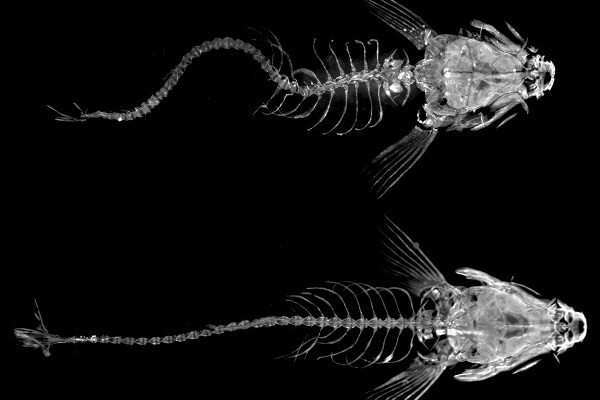
Brian Ciruna
Biography
Dr. Brian Ciruna is Senior Scientist and Head of the Developmental & Stem Cell Biology program at The Hospital for Sick Children (SickKids), and Professor in the Department of Molecular Genetics at the University of Toronto. He received his PhD from the University of Toronto in mouse genetics and embryology, and trained in zebrafish developmental genetics as a post-doctoral fellow at the NYU School of Medicine in New York, NY.
Ciruna's research program elegantly combines experimental embryology with powerful genetic and live imaging technologies using zebrafish to understand the molecular and genetic mechanisms that orchestrate normal development (especially brain and spinal cord formation) and, when defective, cause birth defects and paediatric disease.
Research
A primary focus of the Ciruna Lab is to identify the underlying causes of adolescent idiopathic scoliosis (AIS) - a remarkably prevalent pediatric disorder characterized by rotational deformity of the spine. Unlike congenital or neuromuscular forms of scoliosis, which arise from vertebral anomalies or neuromuscular deficiencies respectively, AIS develops in the absence of other (obvious) physiological defects. 80% of human scoliosis is deemed ‘idiopathic’, a staggering 4% of children will develop AIS, and 1 in 10 patients (predominantly female) experience severe curve progression often requiring physical or surgical intervention.
In pioneering work, the Ciruna lab generated and characterized the first zebrafish models of AIS, providing fundamental new insights into the pathogenesis of disease. Surprisingly, their research implicates ancient and enigmatic CNS organ systems and irregularities in cerebrospinal fluid (CSF) homeostasis in abnormal spine development. They also discovered that downstream of CSF defects, activation of pro-inflammatory signals, and oxidative stress within the CNS ultimately drive spinal curvature and that immunomodulating therapies can significantly reduce the incidence and severity of scoliosis in zebrafish models.
Dr. Ciruna and his team continue to define specific molecular and biological mechanisms underlying spinal curve progression, interrogate the possible link between neuroinflammation and human AIS, and identify novel targets for therapeutic intervention.
Education
- 1994–2001: Ph.D., Department of Molecular and Medical Genetics, The University of Toronto, Toronto, ON
- 2001–2005: Postdoctoral Fellow, Department of Developmental Genetics, Skirball Institute of Biomolecular Medicine, NYU School of Medicine, New York, NY
- 2005–2012: Scientist, Program in Developmental & Stem Cell Biology, The Hospital for Sick Children, Toronto, ON
- 2006–2012: Assistant Professor, Department of Molecular Genetics, The University of Toronto, Toronto, ON
- 2006–Present: Faculty Member, Collaborative Specialization in Developmental Biology, The University of Toronto, Toronto, ON
- 2012–2017: Associate Professor, Department of Molecular Genetics, The University of Toronto, Toronto, ON
- 2013–Present: Senior Scientist, Program in Developmental & Stem Cell Biology, The Hospital for Sick Children, Toronto, ON
- 2016–Present: Program Head, Program in Developmental & Stem Cell Biology, The Hospital for Sick Children, Toronto, ON
- 2017–Present: Full Professor, Department of Molecular Genetics, The University of Toronto, Toronto, ON
Achievements
- 2006: Career Development Award – International Human Frontiers Science Program Organization
- 2007: Canada Research Chair (Tier II) in Developmental Genetics and Cell Biology
- 2011: Ontario Early Researcher Award – Ontario Ministry of Research and Innovation
- 2018: Canada Research Chair (Tier I) in Developmental Genetics and Disease Modeling
- 2019: Vice President, The International Consortium for Spinal Genetics, Development and Disease (ICSGDD)
Publications
- Rose CD, Pompili D, Henke K, Van Gennip JLM, Meyer-Miner A, Rana R, Gobron S, Harris MP, Nitz M, Ciruna B. (2020) SCO-Spondin Defects and Neuroinflammation Are Conserved Mechanisms Driving Spinal Deformity across Genetic Models of Idiopathic Scoliosis. Current Biology. Jun 22;30(12):2363-2373. Epub 2020 May 7.
- Van Gennip JLM, Boswell CW, Ciruna B. (2018) Neuroinflammatory signals drive spinal curve formation in zebrafish models of idiopathic scoliosis. Science Advances. Dec 12;4(12):eaav1781.
- Boswell CW, Ciruna B. (2017) Understanding Idiopathic Scoliosis: A New Zebrafish School of Thought. Trends in Genetics. Mar;33(3):183-196. Epub 2017 Feb 4.
- Grimes DT, Boswell CW, Morante NF, Henkelman RM, Burdine RD, Ciruna B. Zebrafish models of idiopathic scoliosis link cerebrospinal fluid flow defects to spine curvature. Science. Jun 10;352(6291):1341-4.
- Hayes M, Gao X, Yu LX, Paria N, Henkelman RM, Wise CA, Ciruna B. (2014) ptk7 mutant zebrafish models of congenital and idiopathic scoliosis implicate dysregulated Wnt signalling in disease. Nature Communications. Sep 3;5:4777.
See a full list of Brian Ciruna's publications.
External Funding
- Canadian Institutes of Health Research (CIHR)
- Canada Research Chairs (CRC) Program
- National Institutes of Health (USA)
Relevant pages

Researchers at The Hospital for Sick Children (SickKids) have determined that neuroinflammatory signals drive spinal curve formation in zebrafish, and can be suppressed using common drugs like NAC.

